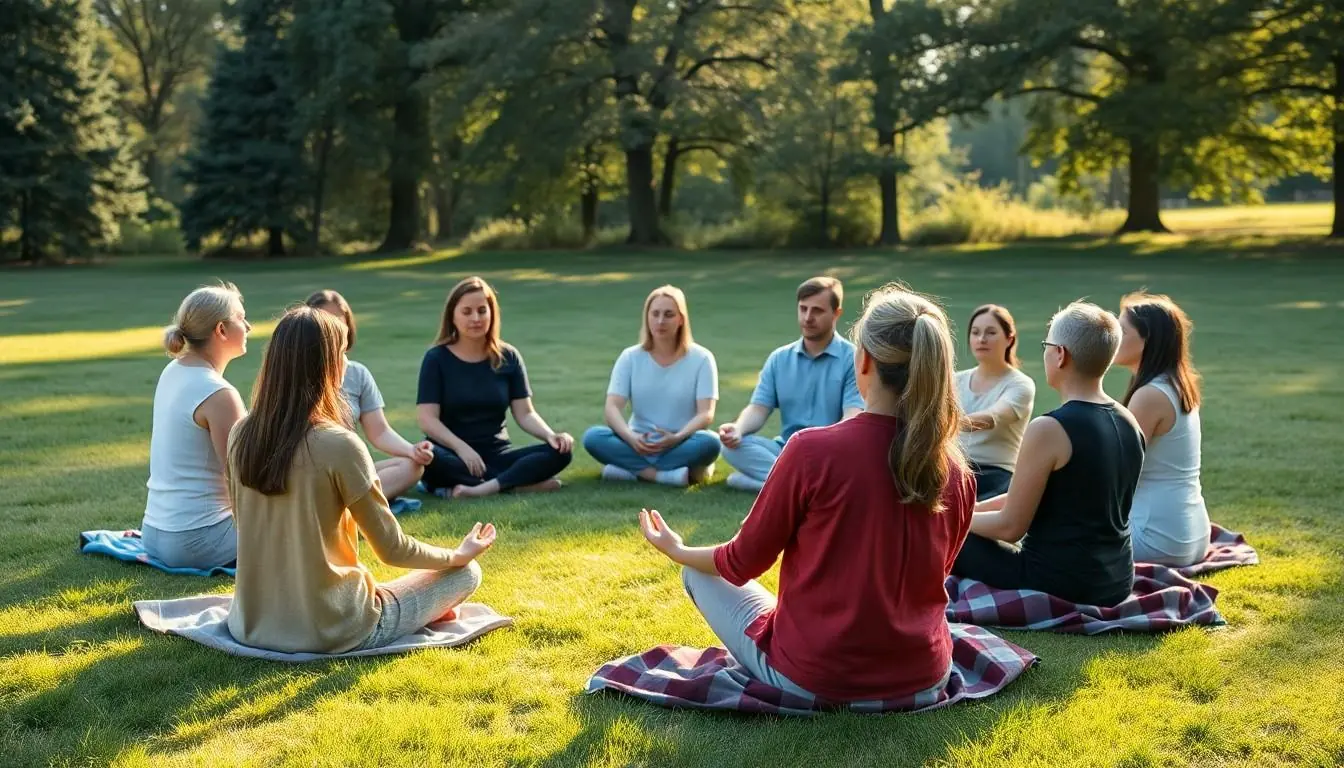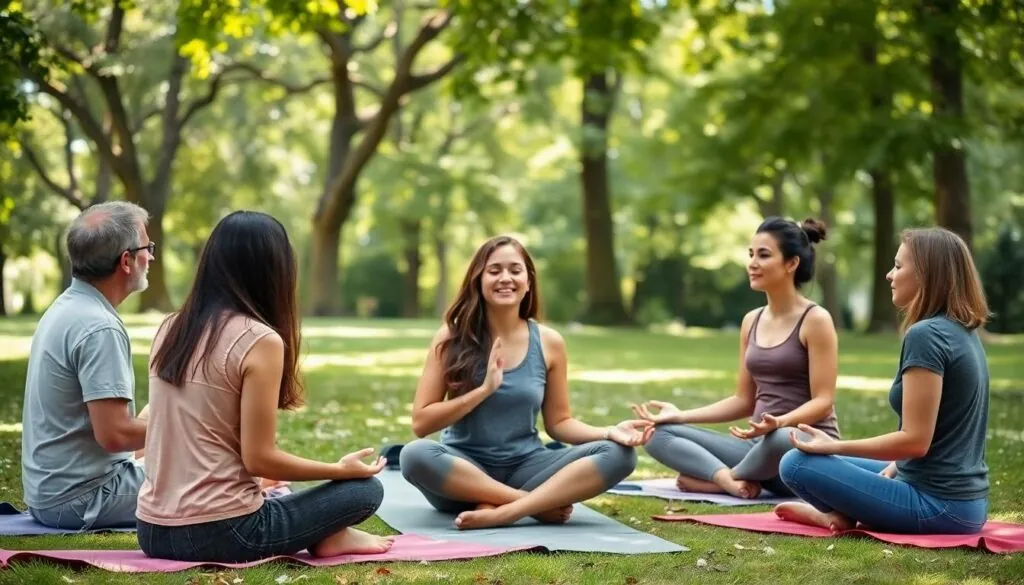In today’s fast-paced world, finding a moment of peace can feel like searching for a needle in a haystack. Enter mindfulness exercises for groups—a fun and effective way to cultivate calmness and connection. Imagine a room filled with laughter and relaxation, as participants engage in activities that not only reduce stress but also strengthen bonds.
Table of Contents
ToggleOverview of Mindfulness
Mindfulness represents a mental state achieved by focusing awareness on the present moment. Practicing mindfulness encourages acceptance of thoughts, feelings, and bodily sensations without judgment. Techniques may include meditation, breathing exercises, or body scans, each designed to cultivate a deeper awareness of the self.
Groups that engage in mindfulness exercises often experience benefits such as reduced stress and improved emotional regulation. Participants find themselves more connected to their surroundings and each other, creating a supportive environment for growth. Implementing group mindfulness practices can foster teamwork and enhance communication skills among members.
Popular mindfulness exercises include guided meditation sessions, mindful walking, and gratitude sharing. Guided meditation allows participants to focus their thoughts while listening to calming instructions. Mindful walking emphasizes the connection between body and mind, encouraging participants to be aware of their movements and surroundings. Gratitude sharing fosters positive emotions as individuals express appreciation for aspects of their lives, reinforcing a sense of community.
Evidence shows that consistent mindfulness practice can improve overall mental health. Studies indicate that individuals engaging in group mindfulness activities report less anxiety and higher levels of well-being. Regular participation promotes resilience, enabling individuals to navigate life’s challenges with greater ease.
Incorporating mindfulness exercises into group settings can transform interpersonal dynamics and enhance individual well-being. Providing a structured approach to mindfulness helps participants establish a routine that nurtures personal and collective growth. Activities designed for groups deliver both immediate and long-term benefits that become integral to everyday life.
Benefits of Mindfulness Exercises for Groups

Mindfulness exercises for groups yield various benefits that enhance interpersonal relationships and overall well-being. These activities promote a supportive environment, leading to improved connections among participants.
Enhancing Group Cohesion
Group mindfulness practices encourage collaboration and trust. Participants engage in shared experiences, fostering a sense of belonging. Trust builds through open communication during exercises, which helps group members express themselves without fear of judgment. Activities like mindful listening and gratitude sharing strengthen emotional bonds, creating a more cohesive unit. Regular practice cultivates a supportive atmosphere, where individuals feel valued and understood. As participants engage with each other, they develop empathy, enhancing group dynamics and collaboration.
Reducing Stress and Anxiety
Mindfulness exercises significantly reduce stress and anxiety among participants. Group activities create a shared space where individuals can release tension through collective practice. Participants often report feeling calmer and more centered following mindfulness sessions. Techniques like guided meditation and mindful breathing lower cortisol levels, alleviating feelings of stress. Engaging in these exercises together often introduces a communal support system, where shared experiences foster resilience. Lower anxiety levels promote a sense of safety and well-being, allowing individuals to approach their lives more positively. Overall, group mindfulness cultivates an environment conducive to mental tranquility.
Types of Mindfulness Exercises
Mindfulness exercises come in various forms, each designed to enhance awareness and connection among participants.
Breathing Techniques
Breathing techniques focus on the rhythm of breath to promote relaxation. Participants engage in deep inhalations followed by slow exhalations, creating a calming effect. Various methods exist, including diaphragmatic breathing and box breathing. Diaphragmatic breathing emphasizes using the diaphragm to enhance oxygen flow. Box breathing combines equal inhalations, breath holds, exhalations, and pauses, typically lasting for four counts each. Practicing these techniques collectively fosters a shared sense of tranquility and community engagement during sessions.
Guided Visualization
Guided visualization leads groups through imaginative scenarios to evoke relaxation and positive emotions. Facilitators often narrate vivid scenes, such as serene beaches or peaceful forests, allowing participants to visualize their surroundings deeply. Participants focus on sensory details, enhancing their immersive experience. This exercise encourages mental imagery to release anxiety and cultivate a sense of well-being. Group members can share their experiences after the session, promoting connection and deeper understanding among participants.
Body Scan
Body scan exercises encourage participants to develop awareness of their bodily sensations. This technique typically begins at the toes and progresses through the entire body, inviting individuals to notice tension or discomfort. Each participant reflects on physical sensations, promoting acceptance and presence in the moment. As individuals share their experiences afterward, they reinforce emotional bonds within the group. Incorporating a body scan in a mindfulness session enhances personal insight while fostering a supportive atmosphere among group members.
Implementing Mindfulness Exercises in Group Settings
Implementing mindfulness exercises in group settings leads to improved connections and reduced stress. These practices enhance participants’ emotional well-being and strengthen interpersonal bonds.
Preparing the Group
Preparation is crucial for successful mindfulness exercises. Set clear intentions to establish focus and purpose. Invite participants to share their goals, creating a sense of ownership in the process. Establish ground rules to promote respect and confidentiality, ensuring everyone feels safe to express themselves. Encourage open-mindedness, which facilitates a more effective experience. Gathering materials, such as cushions or mats for comfort, enhances participants’ physical and mental readiness. By creating these foundational elements, leaders set the tone for meaningful engagement.
Creating a Supportive Environment
A supportive environment nurtures mindfulness practice. Dim lighting fosters relaxation and encourages participants to feel comfortable. Using calming colors and natural elements helps reduce distractions. Arrange seating in a circle to promote inclusivity and connection among participants. Encourage silence at the beginning, allowing everyone to settle into the moment. Facilitating moments of sharing enhances group cohesion and trust. Incorporating soft background music can further promote relaxation and focus. By cultivating this atmosphere, participants find it easier to engage in mindfulness exercises effectively.
Resources for Mindfulness Exercises for Groups PDF
Numerous resources exist for implementing mindfulness exercises in group settings. Websites like Mindful.org provide a wealth of articles and downloadable content focused on group practices. This platform features guides and tips directly aimed at enhancing group mindfulness experiences.
Additionally, The Greater Good Science Center offers free PDFs that outline various mindfulness exercises suitable for groups. These documents cover techniques that promote engagement and rapport among participants.
Books such as “Mindfulness for Groups” by Kate Hefferon and “The Mindful Way Through Depression” by Mark Williams contain structured activities designed for group settings. Readers can access rich content filled with evidence-backed exercises.
Furthermore, organizations like Calm and Headspace promote group sessions through their apps. These platforms feature guided meditations specifically designed for collective participation, fostering shared experiences that build connections.
Lastly, creating custom PDFs using templates available on Canva allows facilitators to design specific materials tailored to group needs. This option offers flexibility while ensuring that all participants receive pertinent information about the exercises.
Regular use of these resources enhances participants’ overall experience, cultivating mindful awareness and improving interpersonal relationships within groups. By leveraging diverse materials, groups can nurture a supportive atmosphere that encourages collaboration, fostering a deeper sense of community and emotional well-being.
Mindfulness exercises for groups offer a transformative approach to enhancing well-being and interpersonal connections. By engaging in these practices, participants can experience reduced stress and improved emotional regulation. The communal aspect of mindfulness fosters a sense of belonging and trust among individuals.
Utilizing resources like PDFs and guided sessions can further enrich these experiences. As groups come together to practice mindfulness, they cultivate an environment where laughter and relaxation thrive. This not only benefits individual participants but also strengthens the overall community. Embracing mindfulness in group settings can lead to profound personal and collective growth.





